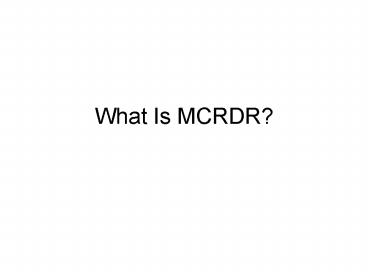What Is MCRDR - PowerPoint PPT Presentation
1 / 10
Title: What Is MCRDR
1
What Is MCRDR?
2
History
- The RDR approach is both an incremental knowledge
acquisition technique and a knowledge-based
system methodology which arouse from the
maintenance problems of a medical expert system - RDR systems have been developed for a range of
tasks. The original RDR approach allowed only a
single classification for a case and was used in
the PERIS system, which provided clinical
interpretations for reports of pathology testing
( Edwords, Compton, Malor, Srinivasan Lazarus,
1993). - RDR has been extended to multiple classification
(Kang, Compton Preston, 1995), control (Shiraz
Sammut, 1997), heuristic search (Beydoun
Hoffman, 2000), configuration (Compton, Ramadan,
Preston, Le-Gia, Chellen Mullholland, 1998) and
resource allocation (Richards Compton, 1999).
3
Concept
- The central idea behind MCRDR is this
- When a domain expert is asked Why does a certain
conclusion apply to this situation? the expert
never explains how the conclusion was reached.
Rather, he or she justifies that the conclusion
is correct. - This justification varies with the context in
which it is given.1 - This viewpoint on knowledge has much in common
with situated cognition critiques of artificial
intelligence and expert systems. (Dreyfus
Dreyfus 1988)2 These critiques do not
necessarily lead to abandoning the expert system
endeavour, but change the focus of development
(Winograd and Flores 19873 Clancey 1991
Clasncey 1993). - 1 Compton, P. and Jansen, R.(1990). A
philosophical basis or knowledge acquisition.
Knowledge Acquisition 2 241 247. (Proceedings
of the 3rd European Knowledge Acquisition for
Knowledge-Based Systems Workshop, Paris 1989,
pp75 89) - 2 Dreyfus, H. and Dreyfus, S. (1988). Making a
mind versus modeling the brain artificial
intelligence back at a branchpoin. Daedalus
117(Winter) pp15-43. - 3 Winograd, T., Flores, F. (1987).
Understanding computers and cognition. Reading,
MA, Addison Wesley.
4
MCRDR Main Concept
- No knowledge engineer
- Easy maintenance
- Handle multiple classification
- Validating during knowledge acquisition
5
MCRDR ALGORITHM How it works?
Get a case
Input Database
System Database
Inference
Knowledge Base
Correct?
Yes
No
Knowledge Acquisition
Cornerstone Case Database
Expert (Simulated Expert)
6
MCRDR ALGORITHM How it works?
Inference Test a rule and if it is true then
test all refinement rules If the rule is a leaf,
the conclusion in the rule becomes one of
conclusion (Rule Path 1, 2, 4) If all refinement
rules are false, the conclusion in the last rule
becomes one of conclusion (Rule Path 3)
Rule Path 1
Rule Path 2
Root
Rule Path 3
Rule Path 4
True
False
7
Rule 1 If a,b then class 1
Rule 5 If e then class 4
Rule 6 If f,e then class 6
Rule 2 If a,c then class 2
Rule 7 If i then class 7
Rule 0 If then then
Rule 10 If g,h then class 5
Rule 3 If k then class 2
Rule 8 If l then class 8
Rule 5 If d then class 5
Rule 9 If i then class 9
Path 1 (Rule 0,), (Rule2, class2), (Rule6,
class6) info 1
Path 2 (Rule 0,), (Rule2, class2), (Rule10,
class5) info 24
Path 3 (Rule 0,), (Rule3, class2) info 3
Path 4 (Rule 0,), (Rule5, class5) info 42
The highlighted boxes represent rules that are
satisfied for the case a, c, d, e, f, h, k.
Pathways through the knowledge base. The rules
producing conclusions are highlighted. Info n
indicates other rule numbers with the same
classification.
8
MCRDR ALGORITHM How it works?
Knowledge Acquisition (I) Location of new
rule Current Conclusions A (Rule Path 1), B
(Rule Path 2) C (Rule Path 3), D (Rule Path
4) Suggest Conclusion C,D,E,F Conclusion to be
deleted A, B Conclusion to be added E,
F Conclusion E and F may be refinements of A or
B (more specific rule). Conclusion E or F may be
added in new rules at higher level and A of B may
be deleted by stopping rules
Rule Path 1
Rule Path 2
Root
Rule Path 3
Rule Path 4
True
False
9
MCRDR ALGORITHM How it works?
Cornerstone Case 1 (B)
Knowledge Acquisition (II) Conditions for new
rule(1) Valid rule conditions The current test
case should be satisfied by the new rule All
cornerstone cases of the refined rule should not
be satisfied by the new rule. The ideal set to
be presented to the expert is Current Case
Union of all cornerstone cases Or Not
(Intersection of all cornerstone cases Current
case). But this may be empty.
Current Case (A)
e
Difference List Between A and (B and C)
a Not d
f
c
d
a
b
g
Cornerstone Case 2 (C)
Difference List Between A and (B and C)
Empty
Cornerstone Case 1 (B)
Current Case (A)
e
Difference List Between A and C
f Not g
f
a
c
d
b
Difference List Between A and B
b Not e
g
Cornerstone Case 2 (C)
10
MCRDR ALGORITHM How it works?
- Condition for new rule(2)
- Suggested Method
- 0. Set the Rnew empty
- 1. Collect temporary set of cornerstone case (S)
for the rule to be refined - 2. Select any case from S and get a difference
list (D) - 3. Add conditions which is selected from D by
expert to Rnew - 4. Remove from S all cases which do not satisfy
Rnew - 5. Repeat from 2 until S is empty
- 6. Rnew becomes the new rules condition































